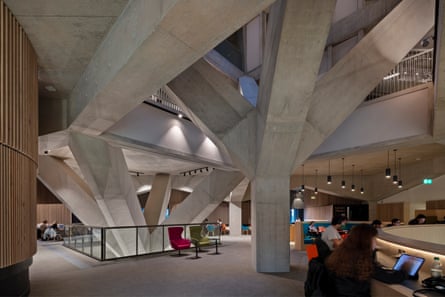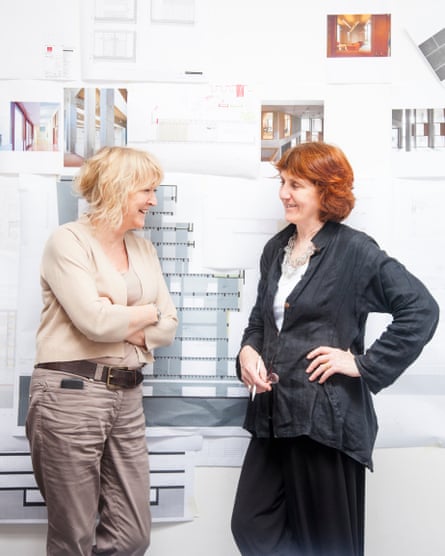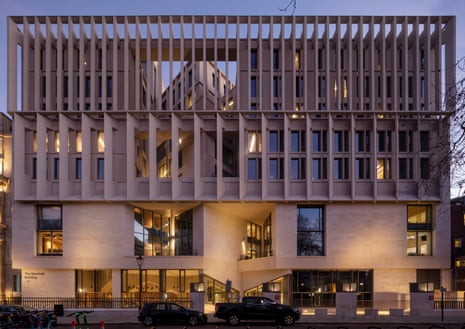One minute, it’s a shish kebab. The next, it’s a washing machine. A second later, it’s a casserole. Speaking to Yvonne Farrell and Shelley McNamara about their new building, the metaphors come tumbling out in a passionate torrent. The two Irish architects, whose practice Grafton won worldwide recognition in 2020 when it won the prestigious Pritzker prize, can’t contain their excitement about their £145m facility for the London School of Economics, partly because they haven’t had a chance to visit it yet. “The pandemic has really made us understand the meaning of longing,” says Farrell. “Site visits on FaceTime just aren’t the same.”
The longing is over for students and academics, though, who return to face-to-face teaching this term, in a place that truly brings home the benefits of meeting in the real world. The new Marshall Building, which looks out over Lincoln’s Inn Fields like a gleaming white palazzo, houses some of the finest spaces that any London university has to offer.
The project is the latest addition to the LSE’s impressive stable of recent commissions, shoehorned into a five-acre tangle of alleyways behind Aldwych in central London. There is the twisted redbrick ziggurat of the student centre, designed by fellow Dublin duo O’Donnell + Tuomey in 2014, which boasts a helter-skelter of alluring nooks and crannies. Then came the glacial slab of the Centre Building in 2018, by Richard Rogers’ firm RSHP, a hi-tech silo of open-plan floors linked by meandering stairs. And, for a final prime site nearby, there is yet another international competition under way, this time for £120m. But the Marshall Building is first time the LSE has had the chance to present a public face to Lincoln’s Inn Fields, the largest public square in London and one of its oldest, having been laid out in the 1630s.

And what an entrance it is. Channelled through a cleft in the Portland stone facade, you arrive inside an expansive hall, where gigantic concrete trees, the kind that might support a flyover, branch out in big brawny wedges. One punches through a hole in the ceiling, continuing its structural journey to the floors above, while a broad spiral staircase licks down in an elegant curl, enticing you up.
If you start to feel woozy from all this heroic concrete gymnastics, it might also be because the floor itself is sloping. This is a practical solution to the one-metre level difference across the site, avoiding the need for steps, but it also adds to the sense of being irresistibly drawn into the great hall, conceived as a covered public piazza. Anyone can wander in off the street and sip a coffee beneath the leaping beams. The terrazzo-paved square will be used for graduation ceremonies and can be transformed into an atmospheric banqueting hall.
There is a good reason for the infrastructural muscle – and it’s not just the architects’ love of Brazilian brutalism. Below the ground floor lies a vast sports hall, along with a gym, squash courts, dance studio and music rooms, repurposing a pre-existing triple-height basement, left over from the former 1960s Imperial Cancer Research Fund labs that occupied the site.
The sports hall required a column-free expanse, which would usually necessitate hefty beams or a massive truss to transfer the weight of the nine storeys above on to the existing basement retaining walls. Working with engineers, AKT II, the team came up with a clever solution, conceiving the transfer structure as a space that could be inhabited. And so the concrete tree-studded great hall was born, with the great wedge-shaped beams tapering towards the centre where they support the column grid above.

Inspiration also came from an unlikely source nearby: the 17th-century Lincoln’s Inn Chapel. The building is raised up on great stone vaults that fan out, creating an open ground floor below massive masonry ribs. “We loved the idea of going upstairs to this other world,” says McNamara, “from a public space below.”
In their building, the spiral stair sweeps up to the two teaching floors, where Harvard-style horseshoe lecture theatres and classrooms are arranged around the edges in curved timber-clad pods, each enjoying daylight and a view out. The space in between is given over to informal seating – shaped, Farrell says, by “tidal lines of students and professors bumping into one another”. It is the kind of place you might want to actually sit and work, rather than just another anonymous corridor filing you from one seminar to the next. Little terraces, cut into the facade, allow a gulp of fresh air and a view of the square between classes.
The departments of accounting, finance and management are stacked above, connected by a light-well (the “shish kebab”) supported by another branching tree. Researchers’ offices are arranged along corridors that radiate from the centre like a sundial, with meeting rooms located at the “social fulcrum” of the stairs, in the hope of sparking encounters. “Architects always think that open studios are the best way to work,” says McNamara. “But researchers are like monks. They like to retreat into a cell where they are completely private, then come out and have the contrast in the more public spaces.”
Farrell rhapsodises a day in the life of this “vortex of thinking”, where an academic might pop downstairs from their office for a game of squash, or come down for a coffee, only to be lured into a music recital, the sounds of Rachmaninov inspiring a breakthrough in their systemic risk modelling. “It’s about convening in a casserole of delight,” she says. “Not silent corridors with ‘Shh!’ signs everywhere.” The noise of this lively casserole shouldn’t travel too far upstairs, thanks to carpeted floors and absorbent materials hidden in walls.

The sheer volume of concrete on show will raise environmental eyebrows, but Grafton insists it can be sustainable. “People say we are just brutalists from Dublin throwing concrete all over the place,” says McNamara, citing the reaction in some quarters when their building for Kingston University won the Stirling prize last year. “It’s cement that’s the dirty word, not concrete, and we’ve worked hard to replace as much of the cement content as possible.”
Gerry O’Brien of AKT II says their embodied carbon assessment of the whole building came out at 650kg of CO2 equivalent per square metre. This works out at almost 12,000 tonnes, which sounds enormous but comes in under RIBA’s new 2030 targets (despite the building having been designed in 2016, when targets were much looser).
While the inside revels in its sheer concrete muscle, with interiors worthy of the Brazilian architect Paulo Mendes da Rocha, the exterior is more deferential to the tastes of Westminster planners. To fit in with its decorous neighbours, the Lincoln’s Inn Fields elevation takes a classical tripartite form, with a solid stone plinth at the lower storeys and two successive layers of white concrete fins, neatly angled in different directions.
“We were concerned that north-facing facades can be very hostile, cold and dreary,” says McNamara. “We wanted to capture as much light as possible from the sides, to animate this facade and draw reflected daylight inside.” It’s a worthy intention, but the result feels a bit stiff, as if the chiselled forms behind have been masked with a prissy veil.
Things get more interesting around the back, where the blocky mass of the building is cut and prised open in different directions, responding to the jumbled streetscape, with terraces and ledges. For Julian Robinson, the LSE’s director of estates, a major victory was convincing the council to pedestrianise one of these streets, on to which a long stone bench now fronts, and where large windows can be fully opened in summer. A curious little building remains clinging to the corner, like a pebble at the foot of a glacier. This is The Old Curiosity Shop, a Victorian fake named to lure Dickens tourists. The LSE bought it during construction and might open it as a Dickensian tea shop.

The thing that helped to summon this great concrete iceberg into being can be found at its very summit. Occupying the penthouse belvedere, with its own panoramic terrace, is the Marshall Institute, a research centre for philanthropy and social entrepreneurship named after Sir Paul Marshall, boss of the £40bn hedge fund Marshall Wace. A prominent donor to the Brexit campaign, and backer of GB News, Marshall contributed £10m to found the institute in 2015, along with £20m towards the building, providing a further £50m last year.
“It’s really our showcase floor,” says Robinson. “High net worth individuals will be brought up here to look out across the city where they’ve made their money – and hopefully be persuaded to part with some of it.”
The spell cast by Grafton’s architecture, as light bounces between the crisp concrete blades, casting a golden glow across this rooftop eyrie, might well make them cough up.

Comments (…)
Sign in or create your Guardian account to join the discussion